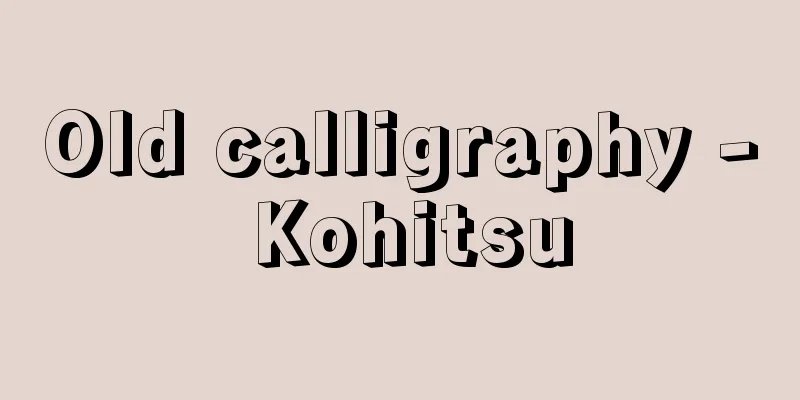Old calligraphy - Kohitsu

|
In a broad sense, it means handwriting of ancient people, but in the history of calligraphy, it is limited to famous Japanese calligraphy from the Heian to Kamakura periods, around the time of Emperor Fushimi (1265-1317), for about 400 years. The most common are collections of waka poems, followed by Chinese poetry and prose, and there are very few stories. The reason is explained by the words of Fujiwara Koreyuki, "Stories are not something that can be written by hand" (Yakakuteikinsho). These were originally complete scrolls or booklets, but as the tea ceremony flourished during the Azuchi-Momoyama period, they were gradually cut into pieces. These fragments, called kohitsugire, were made into hanging scrolls and became tea hanging scrolls, replacing the bokuseki and karae that had been used up until then. Possible reasons for this include the relationship between tea masters and literary arts such as waka and renga, and the fact that waka poems about the four seasons were suited to the tea ceremony, which values the sense of the seasons. Meanwhile, interest in old calligraphy itself was on the rise, and people competed to acquire them. Those with power and wealth boasted larger collections, and Toyotomi Hidetsugu (1568-95) in particular was a fanatical old calligraphy enthusiast. In order to store these old calligraphy and to systematically appreciate them, a convenient old calligraphy handbook was invented. Te means handwriting, and kagami means a tortoise mirror, or something that can be opened and viewed at any time, like a mirror. In other words, it was an album of handwriting. A large book was made using thick paper, and the collected old calligraphy was pasted in a set order. Famous hand mirrors from ancient times include "Kanbokujo" (311 leaves, MOA Museum of Art), "Friends of the Unseen World" (229 leaves, private collection), and "Moshiogusa" (242 leaves, Kyoto National Museum; all of the above are national treasures). The greater the demand for old calligraphy pieces, the more they were cut up. This led to the need to determine the authenticity of the pieces and the identity of the writer, and so experts were in demand. This was the emergence of the old calligraphy masters. The first was Hirasawa Yashiro, who changed his name to Kohitsu Ryosa (1572-1662), and from then on, the name was passed down to his only son, and he inherited the single character "Ryo" and it continued as a family business for many years. On the certificate given to him by Toyotomi Hidetsugu, which bore the legendary pure gold "Kinzan" seal, the name of the writer of the cut, the opening of the cut, and other details were written on it. Among the successive generations of old calligraphy masters, Ryosa had an especially keen eye for appraisal, and produced many masterpieces. In addition, names were given to the old calligraphy pieces, which were named after the owner (Honami-kiri, etc.), the place where they were introduced (Koya-kiri, etc.), when they were cut (Showa-kiri, etc.), the characteristics of the calligraphy style (Hari-kiri, etc.), or the characteristics of the paper (Koushi-kiri, etc.). The names of the authors are often doubtful in today's research, but along with the names of the cut pieces, they are also very useful in Japanese literature as a way to distinguish between the many copies. For example, there are currently 33 copies of the Kokin Wakashu, compiled in 905 (Engi 5), that were identified as old calligraphy from the Heian period, but if you call them "Koya-kiri, attributed to Ki no Tsurayuki" or "Kokinshu-kiri, attributed to Fujiwara no Yukinari," you can be sure that they are one copy. Also, when looking at ancient calligraphy as an art, there are many excellent handwritings, especially those from the 11th century. The beautiful character shapes and refined lines are of a high standard that surpasses other eras. For those who aspire to modern kana calligraphy, they are the highest standard and eternal ideal. [Tamiko Oshita] "Ancient Writings" by Shigemi Komatsu (1972, Kodansha) [Reference] |Source: Shogakukan Encyclopedia Nipponica About Encyclopedia Nipponica Information | Legend |
|
広義では古人の筆跡の意であるが、書道史では、平安から鎌倉時代、伏見(ふしみ)天皇(1265―1317)のころまで、約400年間の和様の名筆に限定される。和歌集がもっとも多く、ついで漢詩文で、物語はきわめて少ない。藤原伊行(これゆき)の「ものがたりは手書(てが)かかぬ事也(なり)」(『夜鶴庭訓抄(やかくていきんしょう)』)のことばがその理由を物語る。これらはもともとは巻子本や冊子本の完全な形であったが、安土(あづち)桃山時代に勃興(ぼっこう)した茶の湯の盛行につれて、しだいに切断されていった。古筆切(こひつぎれ)とよばれるその断簡は、掛幅仕立てにされ、それまでの墨蹟(ぼくせき)や唐絵(からえ)にかわって茶掛とされるのである。要因として、茶人と和歌、連歌(れんが)など文芸とのかかわり合い、季節感を尊ぶ茶の湯に四季を詠じた和歌が適合した点などが考えられる。一方、古筆切そのものの愛好熱も高まり、人々は競って手に入れようとした。権力、財力のある者ほど多数のコレクションを誇り、なかでも豊臣秀次(とよとみひでつぐ)(1568―95)は狂信的な古筆マニアであった。この古筆切の保管、そして系統的に鑑賞するために、便利な古筆手鑑(てかがみ)が考案された。手は筆跡、鑑は亀鑑(きかん)、あるいは鏡のように開けばいつでも見られるものの意。すなわち筆跡のアルバムである。厚手の紙を用いて大型の帖(じょう)をつくり、一定の配列順序に従って、収集した古筆切を貼(は)っていく。古来有名な手鑑に『翰墨城(かんぼくじょう)』(311葉、MOA美術館)、『見ぬ世の友』(229葉、個人蔵)、『藻塩草(もしおぐさ)』(242葉、京都国立博物館。以上いずれも国宝)などがある。 このように古筆切の需要が多くなるほどに、古筆は盛んに切断される。それに伴い、その古筆切の真贋(しんがん)、筆者を鑑定する作業が必要となり、その専門家が求められていく。古筆家(こひつけ)の登場である。初代は平沢弥四郎(やしろう)改め古筆了佐(りょうさ)(1572―1662)で、以後、一子相伝、「了―」の一字を襲名し、長く家業として伝えられた。豊臣秀次が与えた純金という伝説の「琴山(きんざん)」印を押した極札(きわめふだ)には、切の筆者の名とその切の書き出し、特徴などが記入された。古筆家歴代のなかでもとくに了佐の鑑識眼は鋭く、名品が多い。また、古筆切には名称が与えられたが、所蔵者の名にちなんだり(本阿弥(ほんあみ)切など)、伝来した地名(高野(こうや)切など)、切断されたとき(昭和切など)、書風の特色(針切など)、料紙の特色(香紙切など)というように、さまざまにくふうされている。伝称筆者については、今日の研究では疑わしい場合がきわめて多いが、切名とともに、数ある写本を区別する一つの方便として、国文学のうえでも甚だ有効である。たとえば、905年(延喜5)に撰進(せんしん)された『古今和歌集』は、平安時代書写の古筆としては現在33本が確認されているが、「伝紀貫之(きのつらゆき)筆 高野切」「伝藤原行成(ゆきなり)筆 古今集切」などとよべば、確実に一つの写本を特定するからである。 また、書芸術として古筆をみた場合、ことに11世紀のものには優れた筆跡が多い。美しい字形、洗練された線は、他の時代を卓越した水準の高さがある。現在の仮名書道を志す者にとって、最高の規範、永遠の理想となっている。 [尾下多美子] 『小松茂美著『古筆』(1972・講談社)』 [参照項目] |出典 小学館 日本大百科全書(ニッポニカ)日本大百科全書(ニッポニカ)について 情報 | 凡例 |
Recommend
Awazu Hashimoto Offerings
A group that lived in Awazu and Hashimoto (present...
Otogi-so - Otsukinosho
A manor belonging to Daijoin Temple of Kofuku-ji T...
Echeveria setosa - Echeveria setosa
...The leaves are often bluish-white in color, bu...
Nutcracker (star crow) - Nutcracker (English spelling)
A passerine bird of the Corvidae family (illustrat...
Callicebus
…the name of the New World monkeys belonging to t...
Axel, E.
...The spirit of boycotting all theaters that had...
Kimun Kamui - Kimun Kamui
…I means "that" (spiritual being) and &...
Prohibited belt - Kinshitai
⇒Forbidden Zone Source: About Shogakukan Digital D...
Hydrus (Water Snake)
Its abbreviation is Hyi. It is a small constellati...
Novgorod - Novgorod (English spelling)
It is the capital of Novgorod Oblast in the north...
Orbit - Kido
〘noun〙① The path of an object or particle that mov...
Memory Cell - Kiokusel
⇒Memory cell Source: About Shogakukan Digital Daij...
Vámbéry Ármin
1832‐1913 Hungarian orientalist. His real name was...
The Three Journeys of Ohara
The title given to the three brothers Fujiwara no ...
paenitentia
… The Church first included the seven numbers of ...









